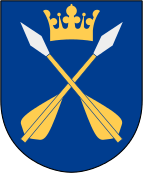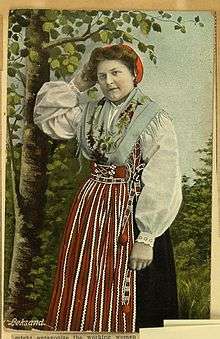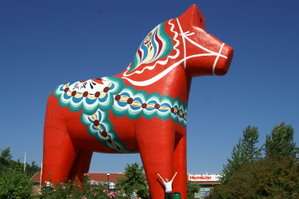Dalarna
Dalarna (Swedish pronunciation: [ˈdɑ̂ːlaɳa] (![]()
Dalarna | |
|---|---|
 Coat of arms | |
 | |
| Coordinates: 60°52′N 14°44′E | |
| Sovereign State | Sweden |
| Land | Svealand |
| Counties | Dalarna County Gävleborg County Jämtland County Värmland County |
| Area | |
| • Total | 29,086 km2 (11,230 sq mi) |
| Population (2019)[1] | |
| • Total | 284,524 |
| • Density | 9.8/km2 (25/sq mi) |
| Ethnicity | |
| • Language | Swedish |
| • Dialect | Dalecarlian |
| Culture | |
| • Flower | Harebell |
| • Animal | Eagle owl |
| • Bird | — |
| • Fish | Minnow |
| Time zone | UTC+1 (CET) |
| • Summer (DST) | UTC+2 (CEST) |
Dalarna adjoins Härjedalen, Hälsingland, Gästrikland, Västmanland and Värmland. It is also bounded by Norway in the west. Borders of the province mostly coincide with the modern administrative Dalarna County (län).
The word "Dalarna" means "the dales" (valleys). The area is a popular vacation destination for Swedes from the south, who often travel there to relax during summer vacations, drawn by good fishing lakes, beautiful campgrounds, and deep forests. Many such Swedes own or rent a second residence in Dalarna, where they are likely to have a vegetable garden and apple trees. In mid-June, summerfest celebrations and dances are held in many of the small villages and in the larger cities. Dalarna is a region full of historical associations, possessing strong local characteristics in respect of its products, and especially of its people.[3] In the western district Lima, some people in villages speak a traditional dialect, Dalecarlian, while in Älvdalen, they speak a dialect as foreign as Norwegian and Danish, Elfdalian.[6] Historically, the people of Dalecarlia – called Dalecarlians, or Dalesmen (dalkarlar, masar) and Daleswomen (kullor) – have been famous for their independent nature toward authority.[3]
The Old Norse form of the province name is Járnberaland,[7] which means "the land of the iron carriers".[8][9][10]
Administration
The provinces of Sweden serve no administrative or political purposes, but function as historical and cultural entities. In the case of Dalarna a corresponding administrative Dalarna County has almost, but not exactly, the same boundaries as the province, except for a part of the north-east (Hamra parish, also known as Orsa Finnmark) which forms part of Ljusdal Municipality, Gävleborg County.
Heraldry
Dalarna's coat of arms dates from 1560; the use of two crossed arrows as a symbol precedes this. A Duchy of Dalecarlia also exists, and the provincial arms include a ducal coronet.
Blazon: "Azure, two Dalecarlian Arrows Or in saltire point upwards pointed Argent and in chief a Crown of the first".
As early as 1525, the arrows appeared in use on a seal. Dalarna County uses the same coat of arms, granted for the then Kopparberg County in 1936.
Geography
The northern part of the province lies within the Scandinavian mountain range: mountainous country with many glacier-created lakes. The southern part consists of plains, with several mines, most notably copper, traditionally forming part of Bergslagen.
Highest point is Storvätteshågna, 1,204 meters above sea-level. Lowest point is at 55 meters, in the south-east part.
Lake Siljan features in the middle part of Dalarna, and the Västerdal River and Österdal River join the Dal River. Dalarna's second lake is Runn, which lies between Falun and Borlänge. With 66.6 square kilometres (25.7 sq mi) of water and over fifty islands, the lake is a popular tourist destination.
Cities
Dalarna was historically divided into chartered cities and districts:
- Avesta (1641–1686, renewed 1919)
- Borlänge (1944, as Borlængio By 1390)
- Falun (1641)
- Hedemora (approximately 1400)
- Ludvika (1919)
- Säter (1642)
- Mora
The cities are since 1971 seats of their respective municipalities.
Other towns
National parks
History
The province of Dalarna formed part of Svealand before the formation of Sweden in the 11th century.
Three historically notorious rebellions started in the Dalarna province:
- In 1434, led by Engelbrekt Engelbrektsson, the miners rose against the oppression of the officers of Eric of Pomerania.
- In 1519–1523 Gustav Vasa found his first and staunchest supporters among the miners in his revolt against the Kalmar Union under King Christian II.
- In 1524–1533 the Dalecarlians and local nobles rebelled against Gustav's increasingly autocratic rule and reformist religious policies; three uprisings were brutally suppressed. Some of the leaders were executed as alleged collaborators of King Christian during the liberation war.
- In 1743, the Dalecarlian Rebellion against the Hats, which was the last major peasants' uprising in Sweden.
Culture


Historically, Dalarna has enjoyed a rich and unique folk culture, with distinct music, paintings, and handicrafts. The province preserved longer than any other the use of the Runic alphabet, a local dialect of which, the so-called Dalecarlian runes or Dalrunes, survived into the 19th century.[11]
A famous symbol of the province is the Dalecarlian horse, in Swedish Dalahäst, a painted and decorated wooden horse. Sulky racing is popular in the region. The high level of calcium in the soil favours horse breeding.
UNESCO has named the mining area of the Stora Kopparberg ("Great Copper Mountain") in Falun a World Heritage Site.
Notable natives
- Lars "Kuprik" Bäckman, chef
- Jussi Björling, opera singer
- Cryonic Temple, heavy metal band
- Joacim Cans, musician
- Björn Dixgård, musician
- Johan Erik Forsström, naturalist
- Lars Frölander, swimmer
- Amanda Hollingby Matsson, singer
- Hypocrisy (band), death metal band
- Emil Janel, Swedish-American artist
- Sixten Jernberg, skier
- Anders Kallur, ice hockey player
- Jenny Kallur, sprinter
- Sanna Kallur, sprinter
- Nils Karlsson ("Mora-Nisse"), skier
- Patrick Johansson, musician
- Carl Larsson, painter
- Gustaf de Laval, inventor-engineer
- Nicklas Lidström, ice hockey player
- Mando Diao, alternative rock band
- Kristian Matsson ("The Tallest Man on Earth"), folk musician
- Kalle Moraeus, musician
- Gunnar Myrdal, economist-politician
- Gustaf Norén, musician
- Charlie Norman, pianist
- Pain, industrial metal band
- Karin Park, pop star
- Tony Rickardsson, speedway rider
- Birgit Ridderstedt, folk singer
- Sabaton (band), power metal band
- Sator, rock band
- Scar Symmetry, death metal band
- Björn Skifs, entertainer
- Gunde Svan, cross-country skier, television presenter
- Peter Tägtgren, musician
- Anders Zorn, painter
- Peter Moren, pop singer, and member of the indie/pop-rock band Peter, Bjorn and John
Dukes
Since 1772, Swedish kings have designated princes as dukes of various provinces, a nominal title.
- Prince August (1831–1873)
- Prince Carl Johan (from his birth in 1916 until his loss of succession rights in 1947)
- Prince Gabriel (from his birth in 2017)
Districts
The Swedish provinces were subdivided into the Hundreds of Sweden, in effect until the early 20th century.
In some provinces the sub-dividing was through districts. Dalarna had only one chartered hundred; the others were court districts.
|
|
Sports
Skiing is popular in Dalarna. Vasaloppet, a cross-country skiing race (the world's longest) of 90 km, takes place annually, usually on the first Sunday of March, between Sälen and Mora. It commemorates the ski-borne escape of Gustav Ericson, who would later become King Gustav I of Sweden, from Danish troops in 1520.
Football in the province is administered by Dalarnas Fotbollförbund. Brage and Dalkurd are examples of football teams in Dalarna. Icehockey is also very popular in Dalarna. The two famous ice hockey teams and rivals from Dalarna are Leksands IF and Mora IK, both frequent in the highest ice hockey division.
Notes
References
- "Folkmängd i landskapen den 31 december 2019" (in Swedish). Statistics Sweden. 2020-03-19. Retrieved 2020-04-20.
- Eric Linklater. The Life of Charles XII. pp. 53–54 and throughout.
- Chisholm, Hugh, ed. (1911). . Encyclopædia Britannica. 7 (11th ed.). Cambridge University Press. p. 764.)
- "Dalecarlia". Merriam-Webster Dictionary. Retrieved April 14, 2019.
- Robert Nisbet Bain (1970) [1894]. Gustavus III and His Contemporaries. Two. New York [London]. pp. 33–35 and throughout.
- Älvdalska - eget språk eller värsting bland dialekter? | Språktidningen, spraktidningen.se
- Asernes Æt, Hunnerhæren mod Kong Frode I.'s danske styrker - 2 personer ved navn "Hun", og 2 personer ved navn "Hunding", verasir.dk
- járn, islex.is
- bera, islex.is
- land, islex.is
- "Yair Sapir Elfdalian, the Vernacular of Övdaln" (PDF). Archived from the original (PDF) on April 6, 2008. Retrieved June 29, 2007.
- article Dalarna from Nordisk familjebok. (in Swedish)
External links
| Wikimedia Commons has media related to Dalarna. |
| Wikivoyage has a travel guide for Dalarna. |
- Dalarna—Tourist site
- Pictures from Dalarna

